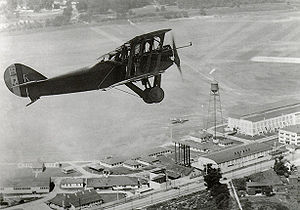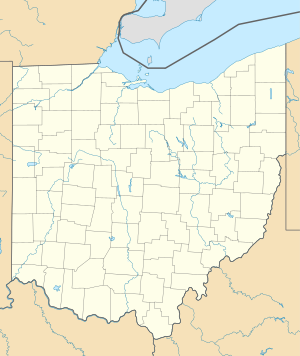McCook Field
| McCook Field | |
|---|---|
| Dayton, Ohio | |

Major W. Schroeder set 30,900 foot two-man altitude record in a Packard-Le Peré LUSAC-11 Biplane at McCook Field, 24 September 1919
|
|
| Coordinates | 39°46′33″N 84°11′27″W / 39.77583°N 84.19083°WCoordinates: 39°46′33″N 84°11′27″W / 39.77583°N 84.19083°W |
| Type | Aircraft Flight Testing |
| Site information | |
| Controlled by |
|
| Site history | |
| Built | 1917 |
| In use | 1917–1927 |
| Battles/wars |
World War I |
McCook Field was an airfield and aviation experimentation station in Ohio operated by the Aviation Section, U.S. Signal Corps and its successor the United States Army Air Service from 1917 to 1927. It was named for Alexander McDowell McCook, an American Civil War general and his brothers and cousins, who were collectively known as "The Fighting McCooks".
In 1917, anticipating a massive need for military airplanes by the United States during World War I, six Dayton businessmen including Edward A. Deeds formed the Dayton-Wright Airplane Company in Dayton, Ohio. In addition to building a factory in Moraine, Ohio, Deeds built an airfield on property he owned in Moraine for use by the company. Deeds was also interested in building a public aviation field along the Great Miami River approximately one mile (1.6 km) north of downtown Dayton, purchasing the property in March 1917. He called it North Field to differentiate it from the South Field in Moraine.
The United States entered the war before he could develop North Field. Deeds sold his interest in the Dayton-Wright Company to become a member of the Aircraft Production Board, on which he served until August 2, 1917, then accepted a commission as a colonel in the Signal Corps and became Chief of the Equipment Division. Its responsibility was to oversee the building of aircraft and engines needed for the Aviation Section. His frustration with the fragmentation of the division and slow progress of the aviation effort led to a recommendation to construct a temporary experimental engineering station. His recommendation for leasing South Field for that purpose was accepted by the War Department but was objected to by the Dayton-Wright Company, which needed the field for wartime production of new aircraft, in particular the DH-4. Instead, the Army leased North Field and opened McCook Field on December 4, 1917.
...
Wikipedia

